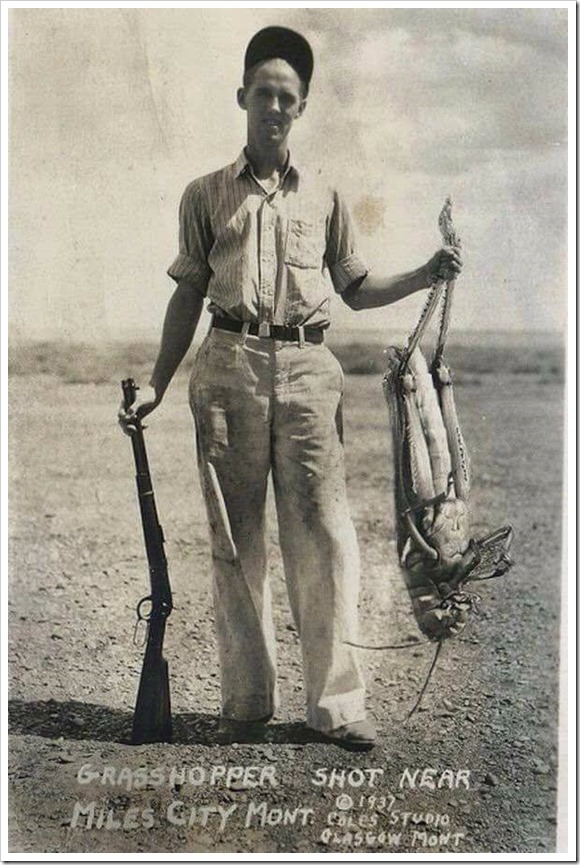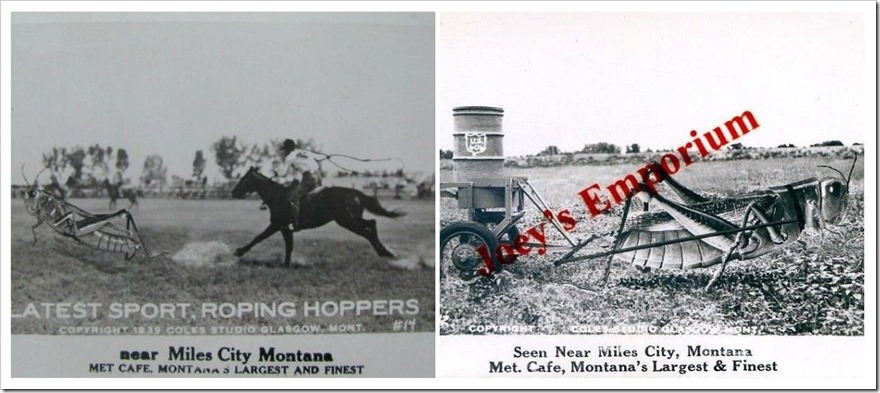This postcard from 1937 causes confusion among viewers - do such monster insects really exist?
We received a few inquiries about this photo, which shows a man who has shot what appears to be a giant grasshopper.
The animal that was shot is proudly presented to the camera.
The photo says:
Grasshopper shot near Miles City Mont. ©1937 Coles Studio Glasgow Mont
And this is what the confusing photo looks like:
Is it true that there actually were such large grasshoppers in Montana (USA)?
Our colleagues at Snopes also reviewed this photo and found the following - this photo was originally a postcard , launched 1935 by Frank D. “Pop” Conard
The Kansas Historical Society writes:
When a swarm of grasshoppers descended on Garden City in 1935, Frank D. “Pop” Conard had a vision. The photographer made a montage of giant insects with humans and sold the postcards like “hotcakes.” “The idea,” Conard said, “came to me after a flight of grasshoppers swarmed into Garden City attracted by the lights, and it was impossible to fill an automobile gasoline tank at filling stations that night. I went home to sleep, but awoke at 3:00 am and all I could think about was grasshoppers. By morning I had the idea of having fun with the grasshoppers, and took my pictures and superimposed the hoppers with humans. I didn't do it for adverse impressions of Kansas, but as an exaggerated joke.” A master retoucher, Conard continued to print “hopper whoppers” until his retirement in 1963. Grasshoppers were enlarged to battle a man, fit on the bed of a pickup, and hold up a train.
The picture postcard presented the possibility to inventive photographers to extend the traditional tall-tale to the photographic plate, and what is more, to devise entirely new forms that were possible only through photography. It brought into being visual effects that tall-tale tellers through the centuries had seen only in their fertile imaginations.
“They say pictures don't lie,” explained Conard, “but from the sale of these postcards-the fastest selling novelty cards on the market it seems that Kansas people like a little funny, untruth.”
When a swarm of grasshoppers invaded Garden City in 1935, Frank D. “Pop” Conard had a vision. The photographer made montages of giant insects with people and sold them as postcards like “hot cakes”. “The idea,” said Conard, “came to me when a swarm of grasshoppers came to Garden City, attracted by the light, making it impossible for me to fill up the gas tank of my automobile at the gas station that night. I went home to sleep, but woke up at 3:00 a.m. and couldn't think about anything but the grasshoppers. At daybreak I had the idea to have some fun with the grasshoppers, took my photos and copied the grasshoppers into each other with the people. I didn’t do it to reflect poorly on Kansas, but rather to make an exaggerated joke out of it.” As a master retoucher, Conard continued printing the “hopper whoppers” until his retirement in 1963. So grasshoppers were enlarged enough to fight with a man, to fit in the back of a pickup truck, and to pull a cart.
…
So, these postcards actually exist, but such giant insects are an artist's idea that has made a huge impact.
Nevertheless, this image could also be exposed as a fake by using a scientific component.
From a biological point of view, grasshoppers of this size could not survive.
Anyone who screams now, there were giant prehistoric insects!! – he is also right, but in our age the rule of thumb for arthropods (insects, spiders, centipedes, etc.) is that anything thicker than a meat sausage would not be able to survive at the current oxygen content of 20%.
Since grasshoppers also breathe largely passively through diffusion via trachea, this respiratory system would only function to a very limited extent if the trachea were more than 2-3 cm (CENTIMETERS!!!) long.
In the Carboniferous era, however, the oxygen content was 35%, which is why it was possible to encounter centipedes measuring over a meter, dragonflies with a wingspan of over 70 cm and other cuddly animals... not everything used to be better!
“The efficiency of breathing via a tracheal system is limited by the rate of diffusion of oxygen, which is one reason for the relatively small size of tracheal-breathing animals.”
Result:
This image is a postcard from the 1930s that was intended as a joke.
From a biological point of view, insects such as grasshoppers can no longer grow that large because the respiratory system would not supply these animals with enough oxygen.
And anyone with a particularly good eye has probably already noticed that a grasshopper of this size would have to cast a shadow over the man's legs...
Still a great idea for making money!
Notes:
1) This content reflects the current state of affairs at the time of publication. The reproduction of individual images, screenshots, embeds or video sequences serves to discuss the topic. 2) Individual contributions were created through the use of machine assistance and were carefully checked by the Mimikama editorial team before publication. ( Reason )



